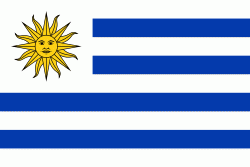Palacio Taranco (Palacio Taranco)
Palacio Taranco, located in front of the Plaza Zabala, in the heart of the Old City of Montevideo, Uruguay, is a palace erected in the early 20th century during a period in which the architectural style was influenced by French architecture. It was designed by French architects Charles Louis Girault and Jules Chifflot León, who also designed the Petit Palais and the Arc de Triomphe in Paris. This building contains European furniture and drapings and currently contains the Museum of Decorative Arts in Montevideo. The palace is often used as a meeting place by the Uruguayan government.
The palace was erected on the site of Montevideo's first theatre in the historical centre of the city which had been built in 1793. The Taranco Ortiz family commissioned the construction of the building in 1907 and it was completed in 1910. In 1943 the Uruguayan state purchased the residence and part of the furniture and gained access to its works of art, but it wasn't until 1972 that it became a museum, and it was declared a National Historic Landmark in 1975.
The Museum of Decorative Arts contains various paintings, sculptures, textiles, ornaments, and European furniture. On the ground floor and first floor of the building can be found some of the furniture of Louis XV and Louis XVI finely inlaid; the works of Ribera (1591–1652), Teniers (1610–1690), Mierevelt (1567–1641), Van der Helst (1613–1670), Appiani (1754–1817), Pradilla (1846–1921), Zuloaga (1870–1945), and Sorolla (1863–1923); Benlliure sculptures (1862–1947), Bouchard (1875–1969), Landowski (1875–1961), Vermare (1899–1919) etc. The Decorative Arts Museum has an important collection of Classical Art and Archaeology in the basement, consisting of artifacts of ceramics, glass, and bronzes and various items related to Greco-Roman and Near East art and archaeology. The museum also has collections of various textiles, from Persian curtains to Flemish tapestries, and has various ointments, oils, and perfumes.
The palace was erected on the site of Montevideo's first theatre in the historical centre of the city which had been built in 1793. The Taranco Ortiz family commissioned the construction of the building in 1907 and it was completed in 1910. In 1943 the Uruguayan state purchased the residence and part of the furniture and gained access to its works of art, but it wasn't until 1972 that it became a museum, and it was declared a National Historic Landmark in 1975.
The Museum of Decorative Arts contains various paintings, sculptures, textiles, ornaments, and European furniture. On the ground floor and first floor of the building can be found some of the furniture of Louis XV and Louis XVI finely inlaid; the works of Ribera (1591–1652), Teniers (1610–1690), Mierevelt (1567–1641), Van der Helst (1613–1670), Appiani (1754–1817), Pradilla (1846–1921), Zuloaga (1870–1945), and Sorolla (1863–1923); Benlliure sculptures (1862–1947), Bouchard (1875–1969), Landowski (1875–1961), Vermare (1899–1919) etc. The Decorative Arts Museum has an important collection of Classical Art and Archaeology in the basement, consisting of artifacts of ceramics, glass, and bronzes and various items related to Greco-Roman and Near East art and archaeology. The museum also has collections of various textiles, from Persian curtains to Flemish tapestries, and has various ointments, oils, and perfumes.
Map - Palacio Taranco (Palacio Taranco)
Map
Country - Uruguay
 |
 |
| Flag of Uruguay | |
The area that became Uruguay was first inhabited by groups of hunter–gatherers 13,000 years ago. The predominant tribe at the moment of the arrival of Europeans was the Charrúa people, when the Portuguese first established Colónia do Sacramento in 1680; Uruguay was colonized by Europeans late relative to neighboring countries. The Spanish founded Montevideo as a military stronghold in the early 18th century because of the competing claims over the region. Uruguay won its independence between 1811 and 1828, following a four-way struggle between Portugal and Spain, and later Argentina and Brazil. It remained subject to foreign influence and intervention throughout the 19th century, with the military playing a recurring role in domestic politics. A series of economic crises and the political repression against left-wing guerrilla activity in the late 1960s and early 1970s put an end to a democratic period that had begun in the early 20th century, culminating in the 1973 coup d'état, which established a civic-military dictatorship. The military government persecuted leftists, socialists, and political opponents, resulting in deaths and numerous instances of torture by the military; the military relinquished power to a civilian government in 1985. Uruguay is today a democratic constitutional republic, with a president who serves as both head of state and head of government.
Currency / Language
| ISO | Currency | Symbol | Significant figures |
|---|---|---|---|
| UYU | Uruguayan peso | $ | 2 |
| ISO | Language |
|---|---|
| ES | Spanish language |















